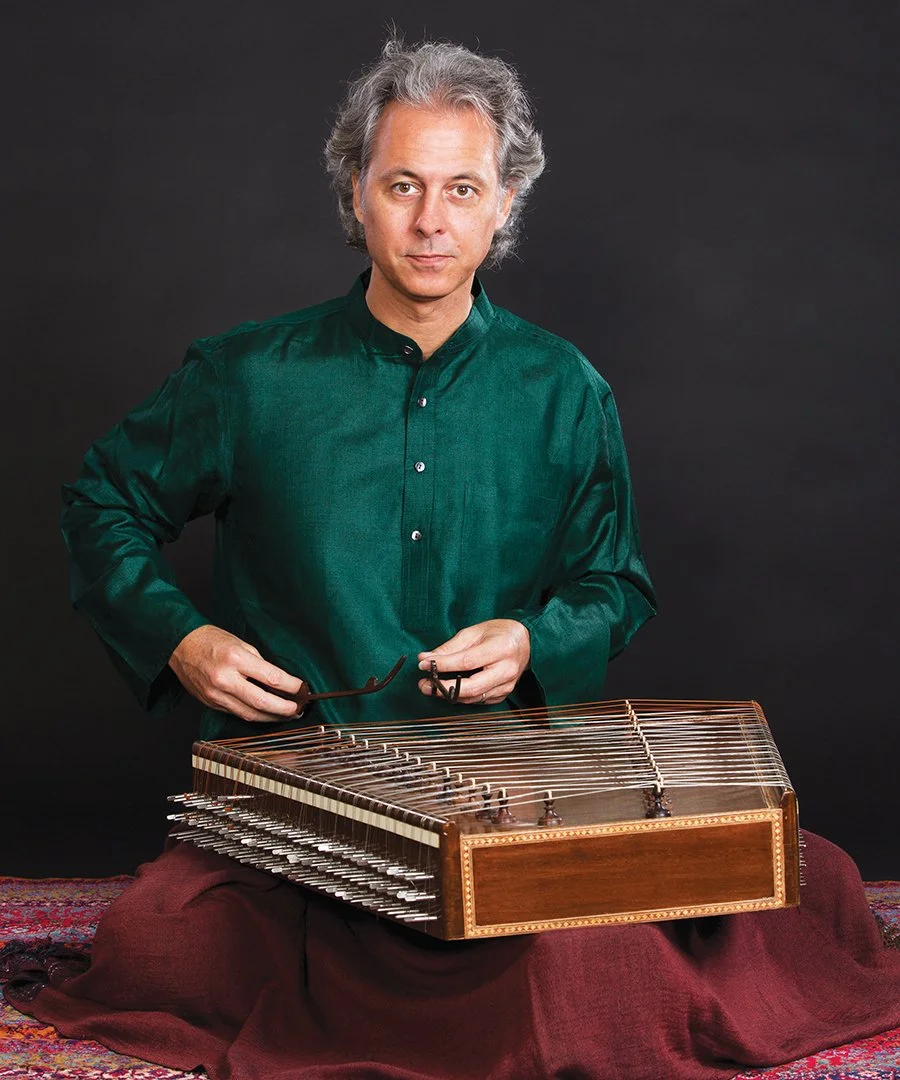SPOTLIGHT
A GURU AND HIS SHISHYA TOGETHER ON STAGE
The guru: Pandit Satish Vyas.
By MOHAMED KHAKI
It was only toward the end of our phone call that Jonathan Voyer, almost in passing, mentioned that his students recite paltas in a theatre class he teaches to tenth-grade students in Montreal.
Just minutes earlier, I had heard a school bell marking the end of class, so I didn’t have time to ask more questions.
Later, however, I found myself struck by the thought: raag sangeet has seeped into such unexpected places! How wonderful that students in a Montreal classroom are reciting melodic patterns derived from sargam (Sa Re Ga Ma Pa Dha Ni Sa) – the Indian solfège, equivalent to Do Re Mi Fa Sol La Ti Do. Come to think of it, the playful Do-Mi-Mi, Mi-So-So, Re-Fa-Fa, La-Ti-Ti phrase from The Sound of Music could easily be considered a kind of palta!
As a lover of raag sangeet, I thought: how cool would it be to hear patterns like Sa Re Ga, Re Ga Ma, Ga Ma Pa, Ma Pa Dha, Dha Ni Sa – and their reverse: Sa’ Ni Dha, Ni Dha Pa, Dha Pa Ma, Pa Ma Ga, Ma Ga Re, Ga Re Sa – echoing through the corridors of more Canadian schools? These simple paltas are the foundation of learning in Hindustani classical music.
Jonathan himself must have practised countless paltas during his time in Dharwad, where he spent a full year in 2003 studying under the renowned vocalist Pandit Somnath Mardur.
“Dharwad is considered a Mecca for musicians,” he says.
Indeed, some of the greatest exponents of Kirana gharana gayaki hail from there. The legendary Bharat Ratna Pandit Bhimsen Joshi, for instance, studied in Dharwad under Pandit Sawai Gandharva (Ramachandra Kundgolkar), whose legacy has been burnished by his brilliant disciple. The Sawai Gandharva Festival in Pune, inaugurated in 1953, commemorates the first anniversary of his passing.
Jonathan’s interest in Indian music was first sparked during his visit to India in 1998. Then an undergraduate at UQAM, he spent nearly five months visiting pilgrimage sites as part of a course in religious studies. For his master’s degree, he returned to India in 2001 to attend the Maha Kumbh Mela in Allahabad (renamed Prayagraj in 2018) – one of the largest religious gatherings in the world. That he chose to return to India so soon after experiencing the overwhelming scale of the Kumbh Mela, with its 70 million pilgrims over six days, suggests that his connection with India was far more than a passing phase.
When asked how he transitioned from vocal music to the santoor, Jonathan said, “I had played drums in a band as a teenager and also studied Bel Canto singing under Louise Yard for nearly ten years. The santoor brought together my love for melody and percussion.”
Though he first encountered the santoor in Dharwad, it was only after being accepted as a student by Pandit Satish Vyas that Jonathan began to pursue the instrument seriously. In 2007, he spent nearly six months in Mumbai and has since made regular trips to India with his partner, Julie Beaulieu – a student and teacher of Bharatanatyam – to continue learning from his guru. In turn, Satishji often visits Jonathan and Julie in Montreal, whether or not he’s performing in Canada.
The disciple: Jonathan Voyer.
Satishji’s own musical path is also somewhat unconventional. Rather than follow in the footsteps of his father – the celebrated vocalist Pandit C.R. Vyas (a Padma Bhushan awardee) – he was drawn to the santoor.
“I was thirteen when my father took me to a concert,” he recalls. “I didn’t even know who was performing. When the curtains opened, I saw this tall, handsome man with an instrument I’d never seen before. I was completely hypnotized for two hours by Pandit Shivkumar Sharma’s performance.”
That night, he told his father he wanted to learn the santoor from Shivji. His father good-humoredly suggested that he first complete his formal education and study vocal music under him. Satishji went on to earn two degrees and an MBA – but he never gave up on his dream of learning from Pandit Shivkumar Sharma, the maestro credited with bringing the santoor, once considered a Kashmiri folk instrument, into the mainstream of Indian classical music.
“I feel incredibly fortunate that Panditji accepted me as a student in 1976,” Satishji says humbly. “Having learned many raags and taals, and occasionally accompanying my father on tanpura, certainly helped speed up my training.”
Today, Satishji is regarded as one of the foremost santoor exponents in India and is a recipient of the Padma Shri. He has performed at major festivals around the world, including several appearances on the Raag-Mala stage.
On June 15, he will appear in a special three-part performance that also features tabla artistes Pandit Mukundraj Deo (accompanying Satishji) and Shawn Mativetsky (accompanying Jonathan).
During our conversation, Jonathan told me, “I get the same excitement and energy when playing drut (the fast-paced concluding section of a raag) that I did when playing rock music.”
I have no doubt that Toronto audiences will feel that same energy – doubled – when they experience the final set performed by both guru and disciple
When and where: June 15, Nanji Family Foundation Auditorium, Aga Khan Museum, 77 Wynford Drive, Toronto. Details and tickets: www.agakhanmuseum.org.
• Mohamed Khaki is the Programming Director at Raag-Mala Toronto.


